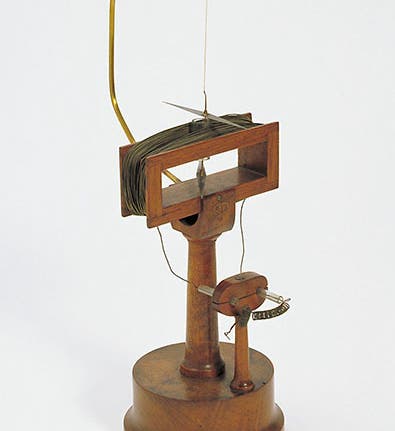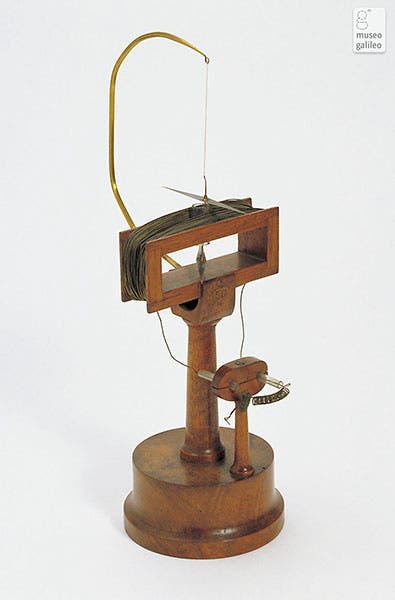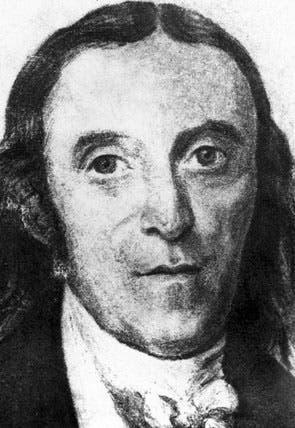Scientist of the Day - Johann Schweigger
Johann Salomo Christoph Schweigger, a German physicist and chemist, was born Apr. 8, 1779, in Erlangen, where he eventually became professor of philosophy at the university there. Schweigger is remembered by historians of physics for a single feat, the invention of the first electromagnetic instrument, the galvanometer. To tell Schweigger's story on this day is tricky, because it depended entirely on Hans Christisan Oersted’s discovery of electromagnetism in 1820, a story we won't be telling until Apr. 21, the anniversary of Oersted's great discovery. Following the calendar does impose constraints, but those are the rules we play by. So for this occasion, we will tell just enough about Oersted so that Schweigger's work makes sense, and then flesh out the Oersted tale in two weeks.
Oersted, working in Denmark in the spring of 1820, had discovered, quite by accident, that a current flowing through a wire, if interrupted (turned on or off) would cause a nearby compass needle to deflect. It was one of those chance effects that a thousand people would not have noticed, but Oersted did, and investigated. To appreciate the magnitude of his discovery, which seems so trivial, you must realize that no one, before Oersted, had discovered any connection between electricity and magnetism. Many books and papers had been written about the two phenomena, noting their similar effects (attraction and repulsion, inverse square laws), but no one had actually made electricity produce magnetism, or vice versa, before Oersted showed that an electric current moving through a wire will cause a nearby compass needle to react as if a magnet were nearby.
The discovery was announced in a paper in the summer of 1820, and Schweigger, like scores of physicists, investigated. He found that the magnetic effect of a single current-carrying wire was minute. If only there were a way to multiply the effect. But of course, there was a way. If he looped the wire into a coil of two or three turns, it was like having three wires, tripling the effect. And if you made a coil with several hundred turns, and put the compass needle inside, you should really be able to amplify the effect. That is what Schweigger did, and it worked. Not only was the deflection of the compass needle greatly magnified, but you could put a scale under the needle and actually measure the deflection, so that you could compare the magnetic effects of different experiments.
Schweigger initially called his instrument a multiplier, which it certainly was, but once it became a calibrated instrument (a “meter”), he wanted the name to reflect that, and so he renamed it a galvanometer, after Luigi Galvani, the Italian discoverer of animal electricity, whom Schweigger must have admired. It is not a great name, since neither Galvani nor animal electricity had anything to do with it. But it is better than schweiggerometer. And whatever name it had, it was the first electromagnetic instrument. We would soon have ammeters, and voltmeters, and even better galvanometers. And all use the same principle that Schweigger built on – producing a magnetic field with a current flowing through a coil of wire.
As for what the original galvanometer looked like, we have no idea. If you search for Schweigger multiplier or galvanometer, you will find one photo on many different sites (first image), and most of the captions imply that it is an original or near original Schweigger instrument. Only the Museo Galileo in Florence (which has the instrument pictured) properly explains that this is a model, made after a galvanometer that Oersted himself later built for his own lab, perhaps 10 years after Schweigger invented it. But once you understand what is being pictured, the photo does a good job of showing the coil, and the two compass needles, within and outside of the coil.
As for Schweigger himself, again we have only one portrait, repeated many times, without a source, which would appear to have been taken from a late nineteenth-century book (second image). Even the German Wikipedia, which uses the photo frequently in various articles, provides no attribution. We include it here with our qualifier, because we have no other images to show besides Oersted’s galvanometer. But it would be nice to validate the portrait by uncovering its source. Any help would be appreciated.
Stay tuned for a post on Oersted, scheduled for Apr. 22, 2024 (since Apr. 21 is a Sunday).
William B. Ashworth, Jr., Consultant for the History of Science, Linda Hall Library and Associate Professor emeritus, Department of History, University of Missouri-Kansas City. Comments or corrections are welcome; please direct to ashworthw@umkc.edu.








